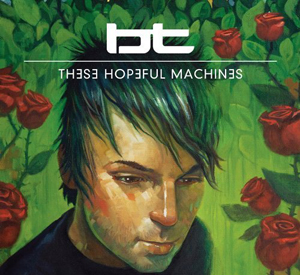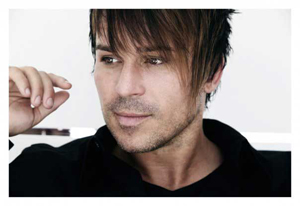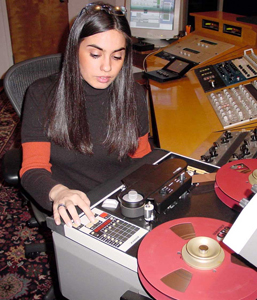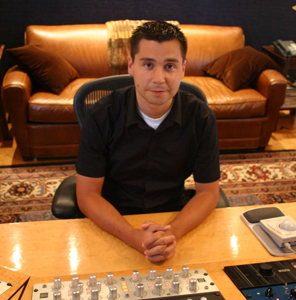BT Remakes Mastering at The Lodge with “These Hopeful Machines”
ASTOR PLACE, MANHATTAN: A man capable of making 6,178 stutter edits in one song, it’s easy to see how a micromanager like BT might somehow miss the big picture. But really, it makes much more sense that BT is quickly evolving methods of mastering just as he slowly, surely is evolving the meaning of music.
There was no such thing as “set it and forget it” when mastering These Hopeful Machines, BT’s expansive — and often deeply amazing – sixth studio album (released Feb. 2). No setting was safe at The Lodge in NYC, where Chief Mastering Engineer Emily Lazar and Mastering Engineer Joe LaPorta would be challenged like never before by a project.
A double disc outpouring of electronic adventures from one of today’s most forward-thinking musical artists, Machines enriches BT’s ability to lovingly lock synths, six-strings, vocals, space, production advances and pure emotion. Songs like the darkly pulsating “Light in Things”, the thickly enchanting “A Million Stars”, and the heartbreakingly addictive “Any Other Way” dare the new decade to step up.
BT, Lazar and LaPorta told us why this finishing process may be the start of something.
Q: BT, This may sound obvious, but why is mastering essential to the success of realizing your vision for an album?
BT: Especially the way music is consumed now, mastering is both the “glue” and the “shine” that makes a recording sound professional. From a personal vantage point, the complexity and precision of my recording and producing process requires an extraordinary attention to detail in mastering. ALL the songs were mastered as stems and all with dynamic – i.e. changing over the course of the composition — compression, EQ and various other settings.
Q: Emily and Joe — What did you learn from mastering previous projects with BT? Why was it valuable to have worked with him previously?
Emily: Well, I first started working with BT back in 2003. Gaëtan Schurrer, a Lodge client and mutual friend, recommended to Brian (Transeau AKA BT) that he call me to master his fourth album, Emotional Technology. Since then, we’ve also happily mastered his 2006 release, This Binary Universe and, of course, his most recent release These Hopeful Machines.
When we work with an artist who is acutely aware of what he/she wants from the mastering process, communication is crucial. Having worked with him before made it both easier to understand his needs and concerns, as well as to address them. In working together on previous releases, we’ve built a relationship where we were able to maintain an open dialogue.
Over the years that conversation has spanned a lot of topics from musical to personal, but for These Hopeful Machines our dialogue was filled with creative, technical ideas to try to reach for the sounds that BT was looking to harness. As far as the mastering on this record is concerned, the addition of Joe LaPorta as Co-Mastering Engineer was invaluable. He brought his own sensibilities to the table, and I think we have an amazing end result because of that.

"These Hopeful Machines" by BT
Joe: BT is really a brilliant composer, sound designer, programmer and musician. He is also technically articulate — I mean, this guy thinks in samples and frames! Mastering a project with him is exciting because you know that it’s going to challenge the listener and sound like nothing he’s ever done before.
Q: What were BT’s expectations/needs from the mastering for “These Hopeful Machines”? How did both sides communicate about this before the mastering process began?
Emily: There were a lot of phone calls and emails before he even sent us the first mixes. It is really essential to our whole process to get on the same wavelength with our clients, because as mastering engineers our desire is not to superimpose The Lodge’s aesthetics on top of a record, but rather to facilitate an artist’s ability to lead us to its completion.
BT was really clear about wanting Machines to remain electronic, but to translate a bit differently than his previous releases. With this album, BT stepped into a more “rock”- oriented territory, adding lots of crunchy, distorted guitars and very large-sounding drums. He really wanted to find a way to enhance that explosive organic rock sound in certain sections of songs — particularly during the climactic choruses — while still highlighting the programming that he is so well known for in others.
With this particular project, BT did a lot of experimentation with us in the pre-production stage to find the “sound” for this record. For example, we played around with printing analog as well as digital source mixes from BT’s stems, and did a whole lot of comparative listening until we found that right “sound.”
Joe: And being that These Hopeful Machines has a lot of material that is very intricate and carefully composed, it was important that we had a very clear idea of BT’s feelings about everything before beginning. One of the most creative conversations for this record started when we began to throw around ideas about using analog tape to achieve some of BT’s desired dynamics, sonic transitions and effects. I think this was the crucial piece of the puzzle that translated into the punchy, organic sound he wanted.
BT: Well, honestly some of these songs demanded to be printed to tape. It was such a joy to do this — and God I forgot how glorious tape sounds. A plug-in will NEVER sound like that!
Q: I understand there was a pretty unusual workflow to master Machines. How would you describe the way the group worked on mastering the album?
Emily: There were some unique challenges that required some slightly unorthodox thinking to overcome, definitely. We suggested something that we always offer to all of our clients looking for a more analog sound after recording and mixing in a digital world — and discussed the possibility of transferring the tweaked stem mixes in stereo to 1” tape to find the warmth and depth that he was looking for. He was thrilled with the sound for certain sections and yet wanted to retain the digital source mix for others.
Joe: At that point we suggested that it was ALL possible, and we gave him some options where he could hear the different source mixes edited together into one cohesive track. It really worked well and we were all pretty excited editing together analog source mixes and digital source mixes multiple times seamlessly within one song. It was quite the effort, but we’re certain that the masters sound that much better because of it!
BT: Many — if not most — of the songs were mastered in sections. There was a discovery process in even arriving at this approach.
Basically, I would give Emily a song and say, “Let’s try a digital mastering with various compression/EQ settings, and also let’s print it to 1″ 30ips and try a 1/2″ at 15ips”, or whatever.
We’d iterate on ideas before even touching the song. After we did literally one song like this, I was like, “Wow, Emily I love chorus on version D — the 1/2″ one — but the digital with heavy compression is unreal for verse 1”. We literally ended up making comp maps, cutting together various versions, and even doing overall amplitude rides on these final, and sometimes very complicated, comps. It was CRAZY and to my ears sounds spectacular. The Lodge is the only place that would do something like this with me, and — wow — did it ever make a difference. If they don’t win an award for it, there’s no justice.
Emily: …And BT was also very open to our suggestions regarding his album sequence.
Joe: Yes, with that many tracks sequencing and transitions can be tricky. We worked together on the best possible flow to tell the album’s story, and BT was very receptive to our input.
Q: Drilling down, was there a particular song or songs that stand out to you as good examples of the above?
Joe: That would be giving away some of the fun of exploring the record! It does take away some of the wonder about what you’re experiencing if we point to it, but check out the album version of “Every Other Way”.
Emily: I agree. Or you could also take a listen to “Suddenly” – that would be another good example. I have to say that BT’s vision for this album is to be listened to from start to finish, like people used to do with vinyl. The sequencing was crafted with that in mind. He named the first disc “Side A”, and the second disc “Side B”.
All I can say is this album is a beautiful journey and each “side” is meant to be listened to from beginning to end.
BT: “Every Other Way” and “Suddenly” — the album versions. They are mastering masterpieces. Emily and Joe are the baddest of all bad asses. The end. No one but them could have done this work.
Q: There were plenty of the BT trademark stutter edits on display. Is there anything that had to be watched out for in particular when mastering songs with a lot of these distinctive sounds?
Joe: Absolutely! There were many, many times we had to double-check whether or not certain sounds were intentional or not.
Emily: That being said, BT is an absolute genius with his programming– he gave us stems for all of the mixes…
Joe: Right…that way if there was ever a question about one of the stutter effects, we could either open up the stem track and check it out or get in touch with him directly.
BT: Stutter edits make mastering harder! Emily repeatedly was like, “Is this three-sample click, right channel, at 9:51 intentional?” Half the time the answer was “Yes”, and half, “No”! It makes it super hard to (have to) stay conscious right up to this album’s final moments of birth. Machines was nowhere near finished until it was mastered.
Emily: This record was a match made in heaven. For us, mastering is a unique combination of two distinct things: the creative with the technical. All music tries to relate some kind of a story to the listener, and we exist to help tell that story.
It felt completely natural to be working on These Hopeful Machines, because, to me, the message of the album focuses on the bridge between the human and the inhuman, man and machine, and what the two can hope to accomplish when working in harmony. In that way the album truly hit upon our mantra as a studio.
Joe: I completely agree. Plus, it’s always great to work with an artist who has such a clear creative vision for his album, yet remains open-minded enough to discover what we can add to take it to the next level. We see mastering itself as really all about that dialogue, that give and take – it’s the subtle blend of technical precision and artistic flair.
Q: Why is Machines an important addition to BT’s catalog, and the musical universe in general — assuming you feel that this album is as big a deal as I do!
Joe: Machines is epic! The detailed textures and swing variations of “Le Nocturne de Lumière” really stand out to me, and the glitchy drum finale of “Every Other Way” instantly blew me away. The overall sound design and production techniques featured in this album are inspiring, and I believe it’s probably his most emotional and moving release to date.
Emily: These Hopeful Machines is a fantastic record. I would love to say that it’s my favorite in the catalog, but everything he’s done has always been a groundbreaking awesome step in a new direction, so I can’t really rank them against each other. Both Joe and I were deeply honored to have been able to work intimately with BT on his latest, soon to be legendary, success! – David Weiss
Please note: When you buy products through links on this page, we may earn an affiliate commission.










Junior
February 3, 2010 at 1:13 am (15 years ago)Cool! Interesting to learn a little about the “behind the scenes” part of a music production.
Junior
February 2, 2010 at 6:13 pm (15 years ago)Cool! Interesting to learn a little about the “behind the scenes” part of a music production.
Gold Cobra
February 3, 2010 at 12:37 pm (15 years ago)A great read and a welcome insight into an extraordinary album. Thanks.
Gold Cobra
February 3, 2010 at 5:37 am (15 years ago)A great read and a welcome insight into an extraordinary album. Thanks.
Chris Blais
February 4, 2010 at 2:51 pm (15 years ago)Hey thanks so much for this post! Fantastic article!!!!
Chris Blais
February 4, 2010 at 7:51 am (15 years ago)Hey thanks so much for this post! Fantastic article!!!!
Gaëtan Schurrer
March 11, 2010 at 6:15 am (15 years ago)Great to hear that Brian is still going to Emily (and Joe) for his mastering. Having heard Emily’s godly work on a number of projects, I knew she was the best there is and it was a natural recommendation to Brian whose sound always required a great amount of attention to detail. I really look forward to hearing BT’s new album, even more so knowing it’s been through Emily (and Joe’s) incredibly creative mastering process.
As a side note, the link to my name in the article doesn’t work because of a extra comma at the end, and the main link should be myspace.com/lepewsonics rather than the older myspace.com/weirdcontinentaltypes.
Gaëtan Schurrer
March 10, 2010 at 11:15 pm (15 years ago)Great to hear that Brian is still going to Emily (and Joe) for his mastering. Having heard Emily’s godly work on a number of projects, I knew she was the best there is and it was a natural recommendation to Brian whose sound always required a great amount of attention to detail. I really look forward to hearing BT’s new album, even more so knowing it’s been through Emily (and Joe’s) incredibly creative mastering process.
As a side note, the link to my name in the article doesn’t work because of a extra comma at the end, and the main link should be myspace.com/lepewsonics rather than the older myspace.com/weirdcontinentaltypes.
Janice Brown
March 11, 2010 at 2:01 pm (15 years ago)Sorry about that – link fixed! Thanks for your comment.
Janice Brown
March 11, 2010 at 7:01 am (15 years ago)Sorry about that – link fixed! Thanks for your comment.